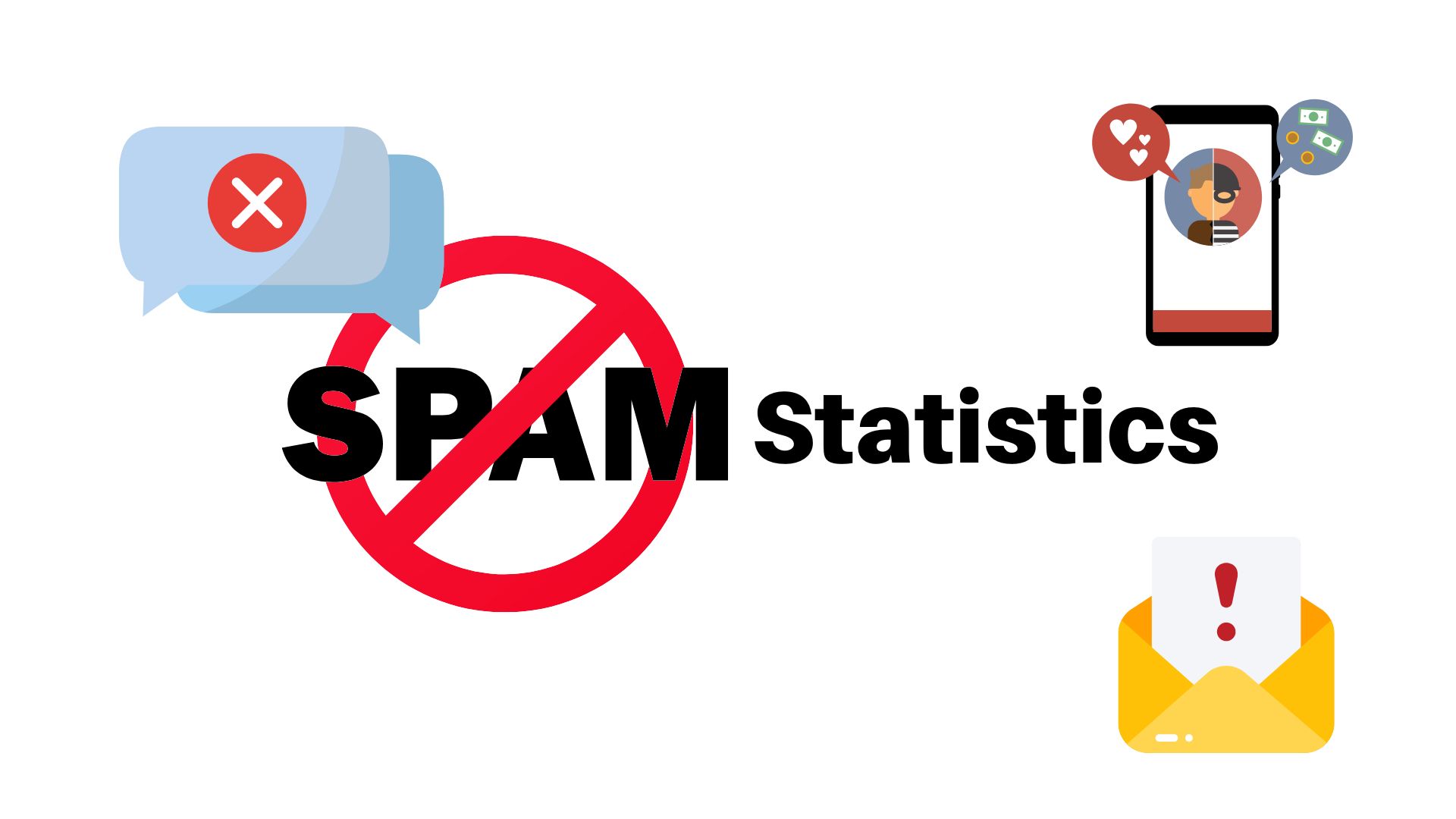2022 Spam Statistics and Facts, Types and Spam-Generating Countries

Page Contents
Introduction
Spam statistics: Spamming! In short, spam means, it is something in any electronic form which is transmitted intentionally or unintentionally to another person. Spam can disturb the computer system. In case of a severe problem if such emails or documents are opened it can totally shut down the system and erase all of the data in it. This spam statistics is designed to give an insight into types of spam with the highest spam-generating countries with live data. General spam statistics have also been considered to date to understand the depth of the problems.
Spam has been troubling everyone since the evolution of the internet era. Using simple and attractive words people around the world are getting stuck and losing all of their fortunes. Spamming people from households as well as corporate has become a daily routine for intruders. But it is in our own hands to play safe from such things.
Key Spam Statistics (Editor’s Choice)
- As of July 2022, Amazon’s impersonated websites were found which were a number of 1,633 websites. This means, for customers on which they think they are shopping on amazon but in reality, the data is duplicated and presented as if it's original.
- In the corporate world, 67.5% of the employees fall pray for such phishing emails and lose their confidential information.
- Spammers are targeting people who have frequent visits to adult content websites.
- During the pandemic year, in the month of March, email phishing increased by 650% around the world.
- According to the reports, cybercrime takes place every 39 seconds
- According to the reports, the reason behind phishing attacks because of the irresponsible action performed by humans without recognizing the phishing emails.
- Spamming also causes threats to non-profit organizations. As per studies, they lose $15,000 every year.
- Most of the time people above the age of 55 get lured by spam as they understand very less of technology compared to the younger generation.
- Received emails that have no subject are referred to as spam because it has been observed that 70% of spammers never write any subject in the mail.
- Around 333 billion emails are sent and received respectively including spam emails.
Types Of Spams
Today there are various ways in which spam is inserted into computer systems. Following are some of those common types.
Malware Spam
When we open unsecured random websites, most of the time we get pop-ups saying our device has detected some kind of malware or virus. If we click on such pop-ups it becomes easy for such spam to enter the system. Most of the time people fall for such messages.
Adult content Spam
This is the most common spam used by attackers by using seductive videos or images by means of email attachments. If such email attachments are opened, the user may see what he intended to, but on the backhand, the virus spreads on a larger basis.
Hoax Spam
Clicking on advertisements such as false promises like losing weight in 10 days, increasing your height, etc. is also another way of spamming people. This is the most common way to fool people
Spam Related To Money
Such kind of spam where advertisers say to give this amount and get doubled in 3 months. Such meaningless ads are full of spam. And this is a way to hack the account and deduct all the money.
Messages On Social Media
Till today we still receive messages such as pass this message to 10 friends of yours and get lucky etc. These types of messages are mostly spread on WhatsApp and people usually believe it under misbelieves.
Email Spams
This is the most dangerous spam happening in the current trend. People impersonate themselves are being someone else with whom they have made some contracts, or we know personally. Under those names, attackers ask for money or just simply harm the systems.
Spam Calls Or Texts
In this type attackers directly ask for any one-time passwords received on the messages or email. They may sound professional while doing this, but it is just a team of hackers and attackers luring people into their traps.
Top 10 Spam-Generating Countries
The spam mentioned in this context is currently live around the world till the date. The list provides the top 10 countries from which spammers are operating.
1. China (14,292) live spams
2. United States of America (7,806) live spams
3. France (862) live spams
4. Turkey (793) live spam
5. Saudi Arabia (792) live spam
6. Mexico (760) live spams
7. Dominican Republic (679) live spams
8. Russian Federation (677) live spam
9. India (644) live spams
10. Germany (597) live spam
General Spam Statistics
Spamming someone has become a routine for digital attackers. When the world is leaping into technology, the dark side is also becoming stronger with the positive side. Digital attackers find any way to attack systems in the world. It is not only laptops that are targeted even mobile phones are being affected by this means. Following are some spam statistics observed by many reports in recent years.
- In the year 2021, 83% of companies around the world faced phishing attacks. Out of which 54% were targeted toward data breaches.
- As of July 2022, Amazon’s impersonated websites were found which were a number of 1,633 websites. This means, for customers on which they think they are shopping on amazon but in reality, the data is duplicated and presented as if it's original.
- Not only Amazon but LinkedIn users also faced phishing attacks in the first quarter of 2022. Around 52% of the users reported the same.
- Mentioning websites such as Cardano, Luno and blochain.com are the most illegitimate phishing 662 attacks around June 2022.
- Received emails that have no subject are referred to as spam because it has been observed that 70% of spammers never write any subject in the mail.
- World’s known web creator GoDaddy was targeted for phishing emails in the year 2021.
- Spammers are targeting people who have frequent visits to adult content websites.
- In the corporate world, 67.5% of the employees fall pray for such phishing emails and lose their confidential information.
- During the year 2020, Russia ranked number one for sending spam emails at the highest number.
- Spammers prefer to impersonate the DLH brand more than any other.
- Digital attacks and their losses are valued at around $5.9 million in recent years.
- During the pandemic year, in the month of March, email phishing increased by 650% around the world.
- During the COVID year, the banking sector was also targeted with around increase of 238%.
- The employees of the World health organization were also targeted in the initial days of the pandemic.
- Phishing along with other cybercrimes increased by 300% in the pandemic period.
- According to the reports, cybercrime takes place every 39 seconds.
- In the United States of America, around 23% of companies report more than 500 suspicious emails every week.
- In the year 2021, middle-scale businesses that were focused on digitalization lost around $1.6 million in cyber-attacks.
- On the other hand, around 43% of the small scale businesses have been a victim of cyber attacks
- In the year 2021, the banking sector ranked the third place for facing the most cyber attacks. Resulting in around 13.82% in total.
- According to the reports, the reason behind phishing attacks because of the irresponsible action performed by humans without recognizing the phishing emails.
- It has been observed that 1 out 4 four promotional emails from top brands include phishing attacks.
- The term spam is derived from the name of the meat.
- In the year 2020, around 47.3% of the emails were spam.
- 94% time malware is transmitted by means of email.
- On the other hand, 45% of spam is transmitted through office files.
- Widows’ applications are also becoming the cause of spamming resulting in 26%.
- Whereas other sources have 22% of involvement in such attacks.
- The system which prevents such virus to enter the system are valued at a market rate of $3.6 billion.
- Gmail servers have blocked around 100 million phishing emails.
- During recent years around $966 million have been lost in such attacks.
- Spamming also causes threats to non-profit organizations. As per studies, they lose $15,000 every year.
- Considering spam statistics, China is a leader in creating such issues.
- After China, Russia becomes the second most problem-causing country in terms of cyber attacks.
- A spamming team operating on a large level accounts for 80% of the internet spam.
- Spam statistics show that even antivirus software was attacked in the year 2020 resulting in 7.76%.
- In the year 2000, Argentina became the world’s first country to legalize anti-spam laws.
- A simple message ‘ILOVEYOU’ caused spam attacks in the old era.
- Around 2.9 billion cases of spam were removed from Facebook in the year 2019.
- LinkedIn’s auto shield took down 98.3% of the spam according to the spam statistics.
- Instagram and Twitter had over 150 million and 70 million spam accounts respectively.
- In the year 2020, around 56 million people were attacked by phone scams and lost millions of money.
- Around 44% of the citizens in the United States of America have reported to received spam COVID-19 alert spam.
- In the year 2020, the United States of America reached number 2 from 8 for titling as the most affected country in terms of spam calls.
- Adult content spam email is counted in 31.7%.
- From the year 2020 to the year 2021, 283 billion out of 336.41 billion emails were detected as spam.
- In the month of December 2021, around 45.37% of emails were recorded as spam.
- Germany ranks 6th in the list of 8.03 billion spam emails.
As of July 2022, the following countries received the following number of spam.
- New York reported 6271,50,910
- Georgia reported 7977,82,825
- Pennsylvania reported 6609,63,041
- Texas reported 9265,40,428
- California reported 945462,222
In the year 2021 following spam messages were reported per person.
- Nevada reported 420.
- New York reported 483.
- Idaho reported 491.
- West Virginia reported 515.
- Texas reported 422.
- Around the world, 11% of people have stated that they keep eye on their spam folder each hour, and the rest 47% look after it every once a day.
- 58% of the users check their spam folders every day.
- Most of the time people above the age of 55 get lured by spam as they understand very less of technology compared to the younger generation.
- Considering the daily spamming, around 20% of the employees click on such emails.
- 17% of people check their spam folder only once a week
- Around 90% of the US population who use email services are vulnerable to spam attacks.
- Around 333 billion emails are sent and received respectively including spam emails.
- Spam emails include in the list of 1,49,513 emails that are sent per minute every day.
- On the other hand, 3.5 million emails are sent each second.
- It is expected to increase the number of email users by the year up to 4.6 billion.
- According to the studies, the United States of America have been facing severe spam issues but yet they are unsolved.
- Phishing emails have the ability to perform data breaches at a 90% of the success rate.
- In the year 2021, every month, around 1.385 million phishing sites were created to increase the attacks.
- Google’s Gmail has the ability to block over 100 million emails which indicates that spam every day.
Conclusion
In the world of technological development, spamming and digital attacks are increasing day by day. It is with mere words that people get attracted. When a person sends a message, and we feel something fishy we should immediately report it rather than ignoring it. This kind of spamming and spreading the virus is extremely dangerous in terms of losing crucial information and confidential data. There’s not a single country that hasn’t been infected with this. But it is our own decision to how to respond to such spam things. As communicating through email is becoming a primary step in the corporate world it is necessary to conduct proper employee training on such spam issues. It is impossible to stop people from spamming as they are huge in numbers and this process is going to continue forever. But with appropriate secured steps we can save the money in the account as well as the confidential data.

Michael Singer is a career coach, podcast host, and author to help you step into a career you're excited about. Currently, He is a coach and trainer helping entrepreneurs and executives achieve business and leadership success. He is also an award-winning business journalist focused on the intersection of technology, Big Data, Cloud, SaaS, SAP, and other trending technology.



